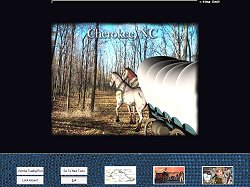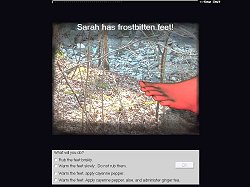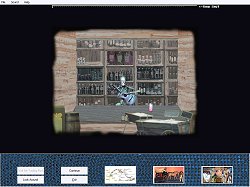|
Cherokee Trails
 In 1838, the Cherokee people were forced to leave their remaining land in what is now Georgia and walk almost 900 miles to new land in what is now Oklahoma. Many did not survive what has become known as the Trail of Tears. This modest little game gives you the opportunity to walk the trail and commune and trade with the ghosts of those that lived and died on the walk.
I do not know enough to presume to make a statement about the place of this game in the broader understanding of Native American history. Suffice to say that if this game was set in Australia and dealt with the trials and tribulations of our own indigenous population, I would feel comfortable stating that any and every opportunity to expose people to the history and culture of the country's original inhabitants should be taken, and the more diverse the range of materials taking that opportunity the better.
Made with the assistance of the Cherokee Nation, this game gives you a glimpse into the legends and lore of the Cherokee, whilst testing your skills as a trader, as well as a hunter, cook, doctor and even a boat builder. You will guide a party of 7 along the trail, moving from town to town, and you are responsible for their ultimate well being. Snakebite, wolf or bear attack, snowstorms, disease and food shortages are dangers which you face, and which, if you make the wrong choices, will result in the end of your journey. Either everyone makes it to the end of the trail or no one does.
The ghosts of those that died before you, presumably from the same sorts of tribulations that will face you, are scattered along the trail. Animal spirits also frequent the path, and you can commune with and learn from all of them. Each has a small tale to tell, should you care to ask. It would be foolish not to, for a number of reasons. In 1838, the Cherokee people were forced to leave their remaining land in what is now Georgia and walk almost 900 miles to new land in what is now Oklahoma. Many did not survive what has become known as the Trail of Tears. This modest little game gives you the opportunity to walk the trail and commune and trade with the ghosts of those that lived and died on the walk.
I do not know enough to presume to make a statement about the place of this game in the broader understanding of Native American history. Suffice to say that if this game was set in Australia and dealt with the trials and tribulations of our own indigenous population, I would feel comfortable stating that any and every opportunity to expose people to the history and culture of the country's original inhabitants should be taken, and the more diverse the range of materials taking that opportunity the better.
Made with the assistance of the Cherokee Nation, this game gives you a glimpse into the legends and lore of the Cherokee, whilst testing your skills as a trader, as well as a hunter, cook, doctor and even a boat builder. You will guide a party of 7 along the trail, moving from town to town, and you are responsible for their ultimate well being. Snakebite, wolf or bear attack, snowstorms, disease and food shortages are dangers which you face, and which, if you make the wrong choices, will result in the end of your journey. Either everyone makes it to the end of the trail or no one does.
The ghosts of those that died before you, presumably from the same sorts of tribulations that will face you, are scattered along the trail. Animal spirits also frequent the path, and you can commune with and learn from all of them. Each has a small tale to tell, should you care to ask. It would be foolish not to, for a number of reasons.
 The first reason is that if you play this game to simply get to the end of the trail you would be missing most of the point, as well as engaging the game at its weakest. It is possible to rush across the country, ignoring every aspect of the game save for the need to find food, but the enjoyment factor will be minimal and your score will be a miserable one.
There is indeed a scoring mechanism, and part of the attraction of this game is trying to beat your score on subsequent occasions. It isn't a long game, which makes it quite easy to play again. You will quickly find that you can score far more if you stop and listen to what the ghosts have to say, and then try and act upon it, than if you put your head down, your tail up, and dash for the end of the trail.
What they tell you may be a snippet from Cherokee lore or traditions, or a reflection from an animal or settler who was present on the trail. What they want are certain items that they will trade for things that you might want and possibly need.
There is also a time factor, and you have only about 50 days to complete the journey. The passing time is represented by a little line of ever increasing white dots at the top of the screen. Failure to get to the end of the trail will abort the mission, but you will still get a score. In fact, your score may be higher than a successful trip. The first reason is that if you play this game to simply get to the end of the trail you would be missing most of the point, as well as engaging the game at its weakest. It is possible to rush across the country, ignoring every aspect of the game save for the need to find food, but the enjoyment factor will be minimal and your score will be a miserable one.
There is indeed a scoring mechanism, and part of the attraction of this game is trying to beat your score on subsequent occasions. It isn't a long game, which makes it quite easy to play again. You will quickly find that you can score far more if you stop and listen to what the ghosts have to say, and then try and act upon it, than if you put your head down, your tail up, and dash for the end of the trail.
What they tell you may be a snippet from Cherokee lore or traditions, or a reflection from an animal or settler who was present on the trail. What they want are certain items that they will trade for things that you might want and possibly need.
There is also a time factor, and you have only about 50 days to complete the journey. The passing time is represented by a little line of ever increasing white dots at the top of the screen. Failure to get to the end of the trail will abort the mission, but you will still get a score. In fact, your score may be higher than a successful trip.
 At least one of the critical aspects of the game in terms of a score is the trading involved. You equip yourself with all manner of items at the flea market before you leave. You can never return, and you can never buy everything, so first time out what you buy to trade will be hit and miss - or perhaps intuition. The people you meet will trade for just about anything, but it is clear there are things they really want.
Some searching on the net indicates that there are two key items that each person or animal you meet is seeking. Trade those items, and not only will your score go up, but you will receive rare items in return. You will soon realise that everyone is prepared to offer you coloured stones, string, cooking herbs, and any number of mundane items as a trade. Boneset (a plant used in a variety of medicinal ways) however comes up far less frequently, and as far as I can tell will only come up when you can offer a sought after item.
What each character tells you will provide a clue as to what they want; for instance, a man who mentions he is an interpreter may well respond favourably to a language book. However you will need to play several times in order to meet everyone (they don't all appear on every journey), and you will then need to carefully scour the numerous flea market items to try and discern what they might be after. Remember, once you have set off, the flea market is no longer available.
One of the advantages in trading for the uncommon items, apart from your score, is that it might give you more options for dealing with a problem that might beset one of your group. If a traveller gets frostbite, you may well be offered only the option of rubbing the affected area. However if you have traded for cayenne pepper, you will be able to apply it should you wish to do so. Up to four options might be open to you, but even with all four you might still not choose the optimal outcome. This might affect not only your score, but also the health of one or more of your party. As intimated above, suffer a death in the party and the game is over. At least one of the critical aspects of the game in terms of a score is the trading involved. You equip yourself with all manner of items at the flea market before you leave. You can never return, and you can never buy everything, so first time out what you buy to trade will be hit and miss - or perhaps intuition. The people you meet will trade for just about anything, but it is clear there are things they really want.
Some searching on the net indicates that there are two key items that each person or animal you meet is seeking. Trade those items, and not only will your score go up, but you will receive rare items in return. You will soon realise that everyone is prepared to offer you coloured stones, string, cooking herbs, and any number of mundane items as a trade. Boneset (a plant used in a variety of medicinal ways) however comes up far less frequently, and as far as I can tell will only come up when you can offer a sought after item.
What each character tells you will provide a clue as to what they want; for instance, a man who mentions he is an interpreter may well respond favourably to a language book. However you will need to play several times in order to meet everyone (they don't all appear on every journey), and you will then need to carefully scour the numerous flea market items to try and discern what they might be after. Remember, once you have set off, the flea market is no longer available.
One of the advantages in trading for the uncommon items, apart from your score, is that it might give you more options for dealing with a problem that might beset one of your group. If a traveller gets frostbite, you may well be offered only the option of rubbing the affected area. However if you have traded for cayenne pepper, you will be able to apply it should you wish to do so. Up to four options might be open to you, but even with all four you might still not choose the optimal outcome. This might affect not only your score, but also the health of one or more of your party. As intimated above, suffer a death in the party and the game is over.
You can also buy food items from trading posts along the way, and you will have to keep a close eye on food stores, It all costs money, so monitor that as well. You can fish for free to supplement your food, but it takes time, time you might not have. Plus not every location has a river, so you might well find yourself foraging for food, which might turn out badly.
A word on the fishing - there is too much of it. I appreciate it is a key element in the game, but you will spend a fair bit of time fishing, whatever your strategy. A little less fishing would have been better.
Your inventory keeps separate track of the items you have to trade, the items you have traded, and all your food reserves. It is accessible from the bottom of the screen, as is a map showing your progress and a separate screen showing the health of all your party. Separate buttons will be available in each town to indicate whether you can visit the trading post or go fishing (never both), as well as to have a look around. When finished, move on to the next town. It's all nicely laid out.
The scenes are single screens, with some ambient sound and minimal motion. The graphics are fairly simple, but each scene has a nice amount of colour and detail. The voice acting is, on the whole, well done and everything is subtitled. It is a game suitable for all ages, as well as adventure novices. Both of my daughters have independently played it, both more than once.
There are many ways you can play this game, and replayability is essential if you are going to get the most out of it. Played as a mad dash across the country, it is unlikely to be terribly satisfying. Similarly, if you only play it once the trading will be hit and miss, and you may well think you have bought a fishing game. Played as a window on a piece of Native American history, it is quietly contemplative and thoughtful. Throw in the added attraction of beating your previous score (you will never beat your 9 year old daughter), and it should provide some fun. It's a low key game which does what it does quite well. It will certainly remain on my hard drive for a while yet, as having cracked 250 we strive to get over 300, and work out the rest of the trade items.
Copyright © Steve Ramsey 2003.
All rights reserved.
System Requirements:
Windows 95/98/2000/XP, Pentium II, 800 x 600 resolution, MP3 capable soundcard.
|
